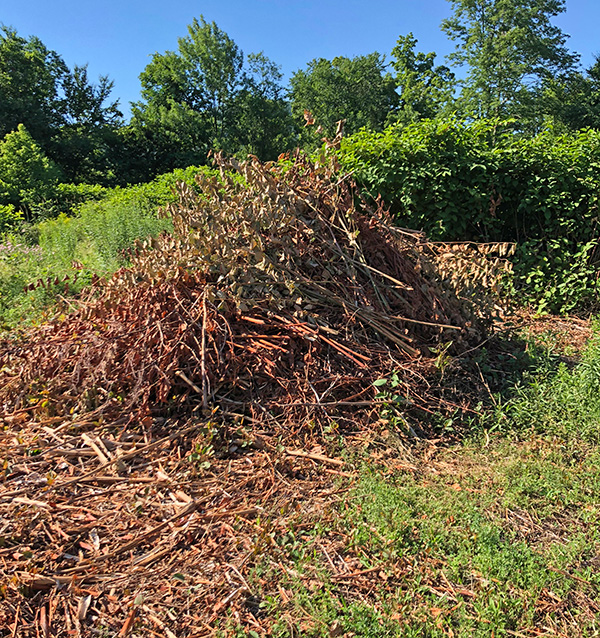Multiple giant cut piles of knotweed are heaped on the Austin parcel in Waitsfield where the town conservation commission conducted an experiment this summer, aimed at controlling and managing knotweed in Waitsfield and all along the Mad River watershed.
Working with contractor Intervale Conservation Nursery (ICN), the Mad River Path Association and community volunteers, the commission has had knotweed and other woody invasives cut on a 1-acre test area of the 5-acre Austin parcel.
Waitsfield conservation commissioner Mark Haberle said that the commission is now working with ICN and its partners on how to properly dispose of the piles of the invasive knotweed. The original plan was to “burrito” the knotweed by wrapping it in black plastic so that it could compost and decompose on site.
“The amount of material exceeded the contractor’s expectation,” he said, noting that after the commission’s last meeting on September 17, stakeholders had a conference call and a final report/recommendation on how to handle the knotweed would be issued.
“Our current thoughts are to compost it in those piles. I guess we can’t burn it. The piles have gotten smaller over the summer and apparently there are a number of pros and cons to each method of dealing with it,” Haberle said.
Haberle said, the conservation commission’s invasives working group has the authority to move forward on the final recommendation from the contractors on how to handle the large, composting piles.
The conservation commission and its partners are working on the details of an October 27 community stewardship day on the site when people will be able to learn more about knotweed and other invasives management as well as planting native species trees.
One of the goals of this knotweed management trial is to see if repeated cutting of knotweed will allow a native forest to regrow on the site.
Haberle said the group also hopes that this trial can lead to people in the community gaining an understanding of how to properly recognize, cut and dispose of knotweed and other invasives on their own property.
The commission will receive a full report from ICN in December that includes the extent of and relative effectiveness of scything and motorized cutting of knotweed and other efforts to remove buckthorn and honeysuckle.
Finally, the issue of invasives management will be on the agenda for this fall’s
Tri-Town Conservation Commission meeting.






